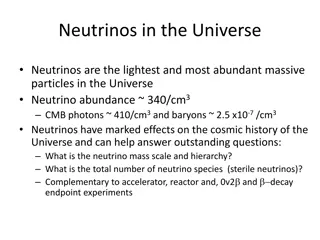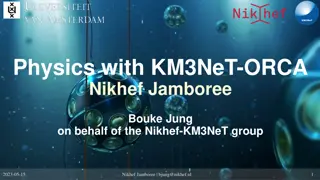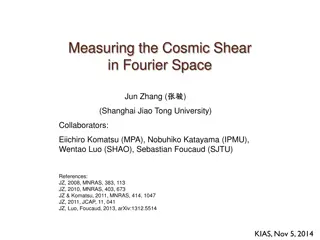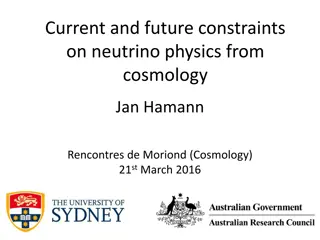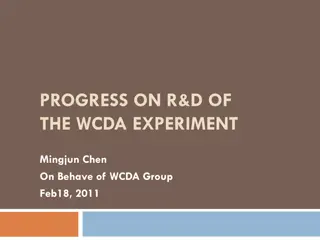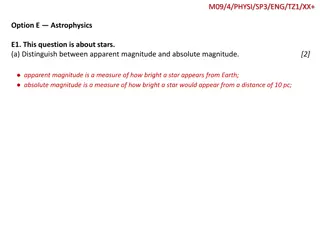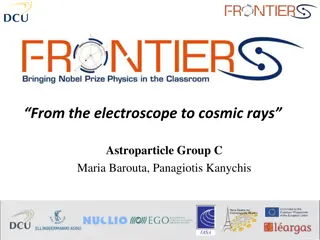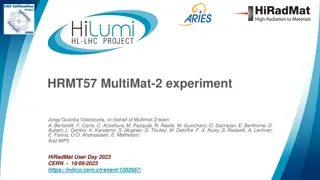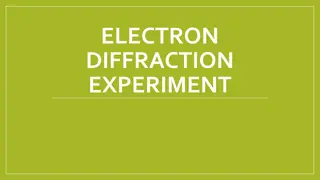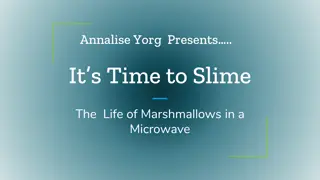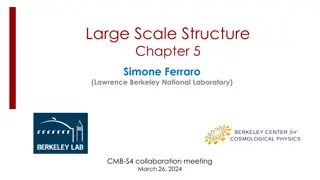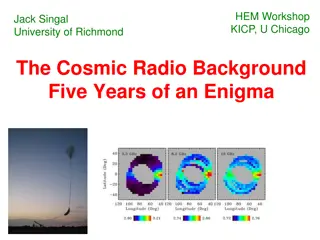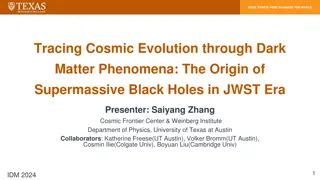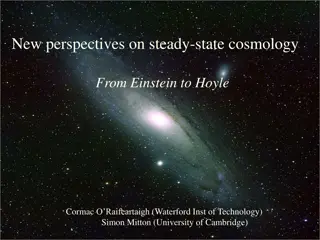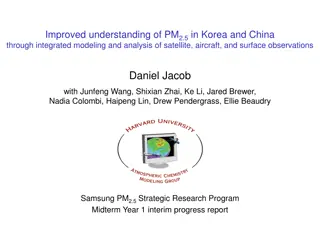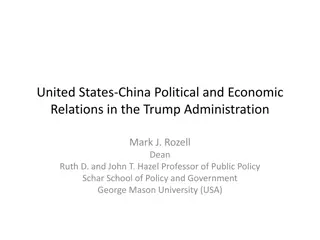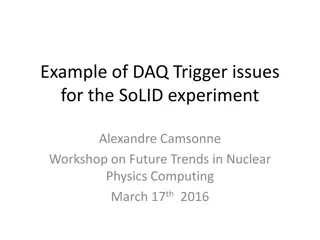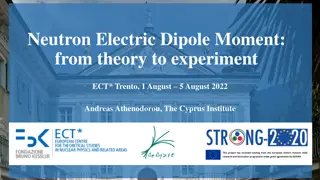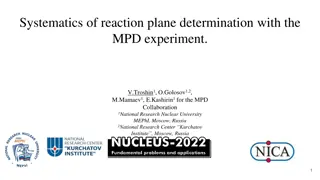Exploring Cosmic Neutrinos: The GRANDProto300 Experiment in LengHu, China
Understanding the mysteries of ultra-high-energy cosmic rays and the connection to cosmic neutrinos is a pivotal quest in astrophysics. The GRANDProto300 experiment in LengHu, QingHai province, China, aims to detect cosmic neutrinos using the Giant Radio Array for Neutrino Detection. The experiment builds on previous research, like the AUGER project in Argentina, to uncover the sources and properties of these elusive particles. Neutrinos, being neutral and weakly interacting, provide a unique window into violent cosmic phenomena and play a crucial role in solving the cosmic ray puzzle. Multi-messenger astrophysics, as exemplified by the NS merger GW170817, combines various signals to unravel nature's mysteries. The workshop led by Olivier Martineau at CNRS-Sorbonne Université further advances our understanding of cosmic neutrinos and their significance in astrophysical research.
Download Presentation

Please find below an Image/Link to download the presentation.
The content on the website is provided AS IS for your information and personal use only. It may not be sold, licensed, or shared on other websites without obtaining consent from the author. Download presentation by click this link. If you encounter any issues during the download, it is possible that the publisher has removed the file from their server.
E N D
Presentation Transcript
LengHu, QingHaiprovince, China Home of the GRANDProto300 experiment The Giant Radio Array for Neutrino Detection http://grand.cnrs.fr/ 1.Why we want to detect cosmic neutrinos 2.How we are going to do that 3.The road to GRAND Olivier Martineau, LPNHE, CNRS-Sorbonne Universit GRAND workshop, DunHuang, April 25
The mystery of Ultra High Energy Cosmic Rays Ionising particles of cosmic origin constantly received on Earth (Hess, 1911) Macroscopic energies (1960s)! E>1020eV ~50 J: kinetic energy of a tennis ball @ 110 km/h (LHC accelerator @ CERN: max particle energy ~1013eV mosquito in flight) Nature-made Human-made
Results of AUGER 1600 detection units over 3000km in Argentina, at the foot of the Andes Huge experiment 3000 km in Argentina 500 people from 14 countries Complex results: UHECRs are charged nuclei (H to Fe) Produced by extragalactic astrophysical sources 60 km Still many open questions: What nuclei exactly? What type of sources? Few individual bright sources or population of many sources? Continous emission or flares? The mystery is not solved yet! One AUGER detection unit
UHECRs are charged particles deviate from source during travel in space because of magnetic fields. Neutrinos are neutral point back to their sources . + very weak interaction probablity: very distant sources can be seen! very clean probe of the violent phenomena in the Universe Sources of UHECRs must also produce UHE neutrinos with energy ~1018eV. (UHECRs do as well, during their propagation in the Universe). Very tight link between UHE neutrinos and UHECRs Neutrinos are key element to solve UHECR mystery. cosmic rays Neutrino is a very important tool for physics: 2 Nobel Prizes in the last 20 years - Solar neutrinos (2002) - Neutrino oscilations (2017)
Multi-messenger astrophysics combine informations to solve Nature s mystery NS merger GW170817
LengHu, QingHaiprovince, China Home of the GRANDProto300 experiment The Giant Radio Array for Neutrino Detection http://grand.cnrs.fr/ 1.Why we want to detect cosmic neutrinos 2.How we are going to do that Olivier Martineau, LPNHE, CNRS-Sorbonne Universit GRAND workshop, DunHuang, April 25
UHE neutrino astronomy: basics Three of the 12 elementary particles of the Standard Model of Physics. Neutral & light (~1eV/c , vs 5 105eV/c for electrons). Huge cosmic neutrino flux @ Earth: ~1011/cm /s (mostly from the Sun) But very tiny interaction probability! For E = 109 eV: p( interaction) = p(proton interaction)x10-12 Cosmic neutrinos have a very large chance to cross the Earth without interaction! Earth
UHE neutrino astronomy: basics Three of the 12 elementary particles of the Standard Model of Physics. Neutral & light (~1eV/c , vs 5 105eV/c for electrons). Huge cosmic neutrino flux @ Earth: ~1011/cm /s (mostly from the Sun) But very tiny interaction probability! For E = 109 eV: p( interaction) = p(proton interaction)x10-12 Cosmic neutrinos have a very large chance to cross the Earth without interaction! For E>1018eV: Interaction probability increases: 106 times larger compared to E=109eV Earth opaque to neutrino if d>1000km. BUT flux drops: at most ~100/km /year. Earth We need a GIANT detector to catch 1018 eV neutrinos.
Only 2 events with E>1015eV: IceCube too small for UHE neutrinos! We need a MUCH LARGER detector!
Neutrino detection by GRAND Very indirect process very unlikely need a GIANT detector. The tau particle has to be produced less than ~100km from Earth surface in order to emerge. Only possible for short underground travels showers with horizontal trajectories.
Why radio? Because it is cheap! perfect for giant detectors Basic cheap
Why radio? Because it is perfect for horizontal air showers! 50-200MHz radio emission of a 1017.5eV shower viewed from the side: ~10s of km detectable footprint @ ~100 km!! Elevation (km) Use mountains as projection screen for radio emission Background level: 15 V/m
Radio detection |E| EE-W EN-S EVert GRANDproto35 antenna Dipole antenna ? = ? ???? VEW Current in antenna due to Efield generates voltage at load output 15
Frequency bandwidth Emission coherent for >>d~3m f<<100MHz max frequency = 200MHz Below 30MHz: short waves min frequecy = 50MHz (see further slides) T. Huege, astro-ph/1601.07426 Simulated galactic bckgd Short waves Measured bckgd noise Background sky @ Ulastai Vertical shower 16
The GRAND project astro-ph/1810.09994 Science China, in press 17
GRAND simulation results Down-going Up-going 5 window Horizontal trajectories only! We need antennas sensitive along the horizon min frequency = 50MHz We want a GUARANTEED detection of cosmic neutrinos by GRAND we need a 200 000km detector (2% of China), great physics program ahead (and huge technical challenge)!
LengHu, QingHaiprovince, China Home of the GRANDProto300 experiment The Giant Radio Array for Neutrino Detection http://grand.cnrs.fr/ 1.Why we want to detect cosmic neutrinos 2.How we are going to do that 3.The road to GRAND Olivier Martineau, LPNHE, CNRS-Sorbonne Universit GRAND workshop, DunHuang, April 25
Autonomous radio detection of air showers Urumqi Beijing Ulastai The TREND experiment, seed for GRAND (2009-2013-2018, 21CMA site) A very remote & quiet site. Simulated galactic bckgd Short waves TREND site, October 2008 Measured bckgd noise TREND @ Ulastai
Autonomous radio detection of air showers The TREND experiment, seed for GRAND (2009-2013-2018, 21CMA site) A very remote & quiet site. Still: radio coinc rate = tens of Hz while air shower rate = ~20/day: huge background rate!!!
Autonomous radio detection of air showers Possible air shower signal The TREND experiment, seed for GRAND (2009-2013-2018, 21CMA site) A very remote & quiet site. Still: radio coinc rate = tens of Hz while air shower rate = ~20/day : huge background rate!!! BUT distinct EAS & background signatures allow for excellent discrimination Also ARIANNA! (astro-ph/1612.04473) Certain background signal TREND data Simulated EAS astro-ph/1810.03070 Astropart. Phys 110 (2019), 15
Antennas produced by Zhang Fushun group @ XiDian TREND succesfull, but Unreliable setup Poor Poor detection efficiency = + discrimination 10% 3% 30% GRANDProto35 Robust setup + fast DAQ (Much) better detection efficiency Polarization measurement + = DAQ pulse tests GP35 presently in commissioning phase @ Ulastai But just a first step towards GRAND! Timetrace length = 3.6 s Timetrace length = 1.8 s
GRAND: still a long way to go How to deal with the HUGE transient event rate [estimated 1kHz/antenna]? How to identify air showers out of the ultra dominant background ? [<100 neutrinos/year vs >1Hz background] How to detect radio signals propagating along the horizon ? [diffraction + attenuation on ground] How to reconstruct the primary particle information [Very inclined events]? How to collect data [1kHz/antenna & tens of kms to DAQ center]? How to deploy and run 200 000 units over 200 000km [Logistics, reliability]? How much will it cost? Who will pay for it? A huge experimental, technical, logist & financial challenge WE DON T KNOW (yet) the answers!!! GP300 first goal: find definite answers to these questions
GRANDProto300 First goal: validate GRAND detection concept Second goal: testbench for GRAND10k because solutions chosen for trigger & data transfer are not scalable to 10000 units! DeepLearning for trigger? T. Charnock, F. F hrer & A. Zilles , IAP
GRANDProto300 Third goal: do nice physics! Air shower physics in 1016.5 1018eV Transition between Galactic & Extragalactic origin of CRs
GRANDProto300 hybrid array GRANDProto300 will be complemented by an independant, autonomous particle detector array with large acceptance to inclined showers (after 2022) Independant detection of electromagnetic & muon components on a shower-to- shower basis, at the detector level. Model-independant measurements of E ( Eelm), Xmax, Xmax and N Optimized & redundant measurement of primary nature elm muons
GRANDProto300 physics program (to be refined) Great tool to study air shower physics in the 1016.5-1018 eV energy range. z z H. Dembinski, UHECR18 Insight on the Galactic-extragalactic transition (large stat+full sky coverage + excellent primary determination)


